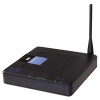Cisco WRH54G User Guide - Page 38
Website Blocking by URL - as repeater
 |
View all Cisco WRH54G manuals
Add to My Manuals
Save this manual to your list of manuals |
Page 38 highlights
Wireless-G Home Router 8. Set the time when access will be filtered. Select 24 Hours, or check the box next to From and use the dropdown boxes to designate a specific time period. 9. Click the Add to Policy button to save your changes and active it. 10. To create or edit additional policies, repeat steps 1-9. Status. Enable or disable a policy. Policy Name. You may assign a name to your policy. Days. Choose the day of the week you would like your policy to be applied. Timing Control. Enter the time of the day you would like your policy to apply. The Router is not designed to have a built-in battery mechanism for a real time clock, so shutting down or rebooting the Router will cause the Router clock to be out-of-date. The Router will automatically check the NTP and correct the time when its internet connection resumes. In case that the NTP is unreachable, you will have to reconfigure the Router clock to ensure that all these time-specific functions will work properly. Because of the interval of the page refresh timing, the clock may have a maximum of two minutes variance. If you have enabled the Timing Control on Internet Access function and leave the Router unused (power-off or not connected to internet) for a long period of time, you will have to check the Router clock and ensure it has the right time by the time you start to use the Router again. If the Router fails to connect to the NTP servers and can't get the time updated, you may need to change to different NTP servers. You have to make sure of the right Router time setting to ensure that Timing Control function works correctly. Blocked Services. You may choose to block access to certain services. Click Add/Edit Services to modify these settings. Website Blocking by URL. You can block access to certain websites by entering their URL. Website Blocking by Keyword. You can block access to certain website by the keywords contained in their webpage. Default Access Rule. This is the global control of the Router's default access rule. It has allow or deny options. If you select allow as the default action, the Router will allow all types of applications at any time to access the Internet. Also you can set up to 10 access control policies to deny the PC or certain types of Internet services in a certain time to access the Internet. Aalso known as the Black List.) If Deny has been selected as a default rule, the Router by default will deny all types of access at any time to access the internet. Also, you can set up to 10 access control policies to allow the PCs or certain types of Internet services in a certain time to access the Internet. (Also known as the White List.) Chapter 5: Configuring the Wireless-G Home Router The Access Restrictions Tab - Internet Access Figure 5-34: Port Services 31















